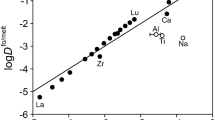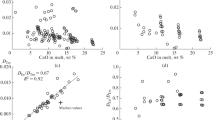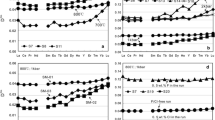Abstract
We present a quantitative model to describe the partitioning of rare earth elements (REE) and Y between clinopyroxene and anhydrous silicate melt as a function of pressure (P), temperature (T) and bulk composition (X). The model is based on the Brice (1975) equation, which relates the partition coefficient of element i (D i ) to that of element o (D o ) where the latter has the same ionic radius r o as the crystallographic site of interest, in this case the clinopyroxene M2 site:
N A is Avogadro's number, E M2 is the Young's Modulus of the site, R is the gas constant and T is in K. Values of E M2 obtained by fitting the Brice equation to experimental REE partition coefficient patterns are in good agreement with those obtained from the well-known correlation between bulk modulus, metal-oxygen distance and cation charge. Using this relationship to constrain E M2 for 3+ cations and then fitting the Brice equation to those experimental data where 3 or more REE partition coefficients had been simultaneously measured we obtained 82 values of D o and r o . The latter was found to be a simple and crystallochemically reasonable function of clinopyroxene composition. We show that for any clinopyroxene-melt pair if D for one middle REE (e.g. Sm or Gd) is known then the Brice equation can be used to predict Ds for all the other REE, with uncertainties similar to those involved in the actual measurements. The model was generalised using thermodynamic descriptions of REE components in crystal and melt phases to estimate the free energy of fusion (ΔG f ) of the fictive REE components REEMgAlSiO6 and Na0.5REE0.5MgSi2O6. For the melt we find that 6-oxygen melt components (CaMgSi2O6,NaAlSi2O6, Mg3Si1.5O6 etc.) mix with constant activity coefficient over a wide range of natural compositions. Propagating ΔG f into the Brice model we obtain an expression for D o 3+ in terms of the atomic fraction of Mg on the clinopyroxene M1 site, the Mg-number of the melt, P and T. The D for any REE can be calculated from D o 3+ using the Brice equation. Over 92% of D REE (454 points) calculated in this way lie within a factor 0.63–1.59 of the experimental value. The approach can be extended to calculate D for any REE at a given P (≤6GPa) and T (12002038K) to within 0.60–1.66 times the true value given only the crystal and/or melt composition. The model has widespread applicability to geochemical modelling of all natural processes involving clinopyroxene, e.g. decompression mantle melting, enabling for the first time account to be taken of variations in partition coefficient in response to changing pressure, temperature and phase composition.
Similar content being viewed by others
Author information
Authors and Affiliations
Additional information
Received: 8 November 1996 / Accepted: 28 May 1997
Rights and permissions
About this article
Cite this article
Wood, B., Blundy, J. A predictive model for rare earth element partitioning between clinopyroxene and anhydrous silicate melt. Contrib Mineral Petrol 129, 166–181 (1997). https://doi.org/10.1007/s004100050330
Issue Date:
DOI: https://doi.org/10.1007/s004100050330




